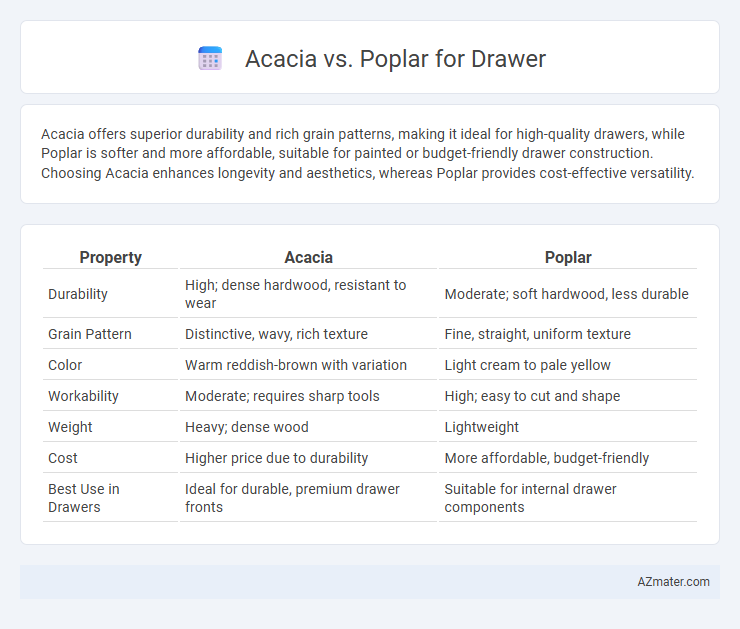Acacia offers superior durability and rich grain patterns, making it ideal for high-quality drawers, while Poplar is softer and more affordable, suitable for painted or budget-friendly drawer construction. Choosing Acacia enhances longevity and aesthetics, whereas Poplar provides cost-effective versatility.
Table of Comparison
| Property | Acacia | Poplar |
|---|---|---|
| Durability | High; dense hardwood, resistant to wear | Moderate; soft hardwood, less durable |
| Grain Pattern | Distinctive, wavy, rich texture | Fine, straight, uniform texture |
| Color | Warm reddish-brown with variation | Light cream to pale yellow |
| Workability | Moderate; requires sharp tools | High; easy to cut and shape |
| Weight | Heavy; dense wood | Lightweight |
| Cost | Higher price due to durability | More affordable, budget-friendly |
| Best Use in Drawers | Ideal for durable, premium drawer fronts | Suitable for internal drawer components |
Introduction: Acacia vs Poplar for Drawer Construction
Acacia and Poplar are popular wood choices for drawer construction due to their distinct properties and benefits. Acacia offers a durable and dense hardwood option with natural resistance to wear and moisture, making drawers long-lasting and sturdy. Poplar, a soft hardwood, provides an affordable, lightweight alternative with smooth grain and excellent paint adhesion, ideal for custom finishes and detailed cabinetry.
Wood Characteristics: Acacia and Poplar Compared
Acacia wood is known for its durability, rich grain patterns, and natural resistance to moisture and insects, making it ideal for long-lasting and visually appealing drawers. Poplar wood, by contrast, is softer and lighter with a more uniform texture, which allows for easier machining and a smooth finish but may dent or wear faster under heavy use. Acacia's higher density and hardness provide superior strength and longevity compared to Poplar, which is better suited for budget-friendly or painted drawer applications.
Durability and Strength: Which is Better for Drawers?
Acacia wood offers superior durability and strength compared to poplar, making it an ideal choice for drawers that require high load-bearing capacity and resistance to wear. Poplar is softer and less dense, which may result in dents and scratches over time, reducing its lifespan for drawer construction. For long-lasting, sturdy drawers, acacia's hardness and natural resistance to moisture provide better performance and structural integrity.
Appearance and Color: Aesthetic Differences
Acacia wood boasts a rich, warm hue with natural variations of golden brown and amber, offering a striking and luxurious appearance for drawer fronts. Poplar features a lighter, more uniform pale greenish to creamy white tone that provides a subtle, modern aesthetic but can appear less vibrant over time. The distinct grain patterns in acacia create a bold, textured look, while poplar's smoother, fine grain delivers a minimalist and clean design ideal for contemporary drawer styles.
Workability: Ease of Crafting Drawers
Acacia wood offers moderate workability with a dense grain that requires sharper tools for smooth machining, making it slightly challenging for detailed drawer crafting. Poplar wood is highly favored for drawer construction due to its soft texture and uniform grain, which allow for effortless cutting, shaping, and sanding. The ease of working with Poplar reduces crafting time and minimizes tool wear, making it a preferred choice for intricate drawer designs.
Cost Comparison: Acacia vs Poplar
Acacia wood generally costs more than poplar due to its durability, attractive grain, and resistance to wear, making it a premium choice for drawer construction. Poplar is a budget-friendly option, offering a smooth surface and easy workability, but it lacks the hardness and moisture resistance of acacia. Choosing between acacia and poplar hinges on balancing initial material cost against long-term durability and appearance.
Sustainability and Environmental Impact
Acacia wood is a highly sustainable choice for drawers due to its fast growth rate and natural resistance to pests, reducing the need for chemical treatments. Poplar, while also a renewable resource, grows faster and is often sourced from managed plantations, making it environmentally friendly but less durable than Acacia. Choosing Acacia supports long-term sustainability with its dense grain and longevity, whereas Poplar offers a lower environmental footprint through rapid renewability and efficient harvesting practices.
Finishing and Maintenance Considerations
Acacia wood features a naturally dense grain that responds well to oil-based finishes, enhancing its rich, warm tones while providing durability against moisture and wear. Poplar, being softer with a uniform texture, often requires primer and paint or clear coats to protect its pale surface and reduce susceptibility to dents and scratches. Maintenance for Acacia drawers involves periodic oiling to maintain luster and water resistance, whereas Poplar drawers benefit from gentle cleaning and occasional touch-ups to painted or sealed surfaces to prevent damage.
Best Uses: When to Choose Acacia or Poplar
Acacia wood is ideal for drawer fronts and furniture requiring durability, water resistance, and an attractive, dense grain, making it perfect for high-use or decorative pieces. Poplar, being a softer hardwood with a fine, uniform texture, is better suited for painted drawer components, interior framing, or budget-friendly projects where smooth finishes and ease of machining are prioritized. Choose acacia for strength and visual appeal in natural finishes, while poplar is preferred when cost-effectiveness and paintability are key factors.
Conclusion: Choosing the Right Wood for Drawer Projects
Acacia offers superior durability, dense grain, and a rich, warm tone ideal for long-lasting drawers with a premium appearance. Poplar is softer, easier to work with, and more cost-effective, making it suitable for painted or budget-friendly drawer projects. Selecting between Acacia and Poplar depends on balancing durability, aesthetics, and budget to achieve the desired drawer functionality and style.

Infographic: Acacia vs Poplar for Drawer
 azmater.com
azmater.com